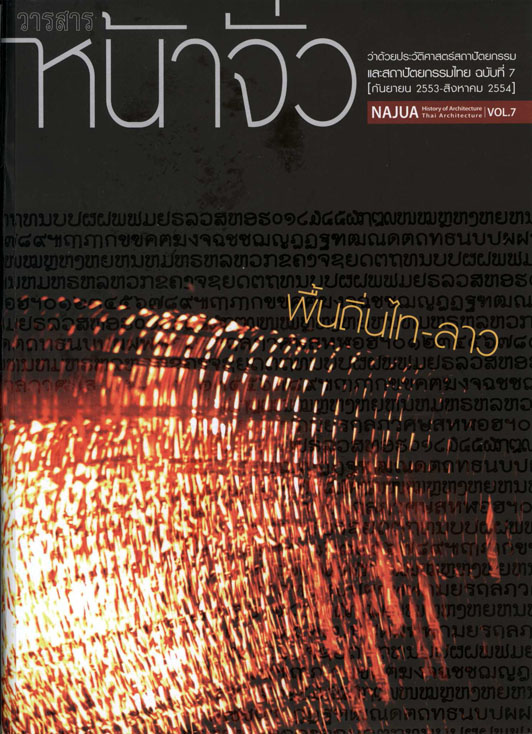การเปลี่ยนถ่ายสัมภาระทางวัฒนธรรมของชาวพวน : จากเชียงขวางสู่ลุ่มน้ำภาคกลางของไทย The Transferability of Phuan Cultural Baggage : From Xieng-Khouang to Thai Central Region
Main Article Content
Abstract
บทคัดย่อ
งานวิจัยชิ้นนี้เน้นการศึกษาการปรับตัวในบริบทใหม่ที่แตกต่างของชาวพวนที่มีถิ่นที่เดิมในแขวงเชียงขวาง สาธารณรัฐประชาธิปไตยประชาชนลาว ซึ่งมีวัฒนธรรมของกลุ่มที่โดดเด่น มีประวัติความเป็นมายาวนานที่ต้องอพยพโยกย้ายถิ่นฐานจากภัยสงครามหลายครั้งหลายคราในช่วงเวลา 200 ปีที่ผ่านมา เข้าสู่พื้นที่ลุ่มน้ำภาคกลางของประเทศไทย ซึ่งเป็นการเปลี่ยนบริบทและวิถีชีวิตจากการอยู่ในพื้นที่สูงท่ามกลางขุนเขาและเนินเขาเข้ามาสู่ลุ่มน้ำภาคกลางของไทย ซึ่งเป็นพื้นที่ลุ่มน้ำท่วมถึง เพื่อศึกษาเปรียบเทียบกับวิถีชีวิตและความเปลี่ยนแปรของหมู่บ้าน เรือนและการดำรงชีพของชาวพวนในพื้นที่เดิม ซึ่งย้อนกลับมาตั้งถิ่นฐานใหม่หลังการเปลี่ยนแปลงการปกครองในลาว จากการศึกษาภาคสนามแบบเจาะลึกในกรณีศึกษาทั้งสองแหล่งที่ตั้งได้พบว่า วิถีชีวิตและบริบทของชาวพวนในแขวงเชียงขวางยังธำรงไว้ซึ่งวิถีแบบจารีต ทั้งการจัดการน้ำ การทำนา หมู่บ้าน เรือน และความเชื่อ แต่รูปลักษณ์เรือนยังไม่สามารถวิเคราะห์พัฒนาการได้ เนื่องจากมีอายุการสร้างเท่ากันหมด แต่ชาวพวนในไทยซึ่งมีปริมาณประชากรในหมู่บ้านมากกว่าในแขวงเชียงขวางมากมาย มีอายุการตั้งถิ่นฐานย้อนถึง 200 ปี มีลักษณะความสัมพันธ์ระหว่างบริบทและวิถีชีวิตที่ยังแนบแน่น แต่แปรไปตามทิศทางการพัฒนาเศรษฐกิจสังคมของภาครัฐ สัมภาระทางวัฒนธรรมที่หอบหิ้วมาจากเชียงขวางปรากฏเด่นชัดในหมู่บ้านเก่าแก่อายุเกิน 100 ปี และค่อยๆ มีความแปรเปลี่ยนไปตามช่วงเวลา โดยเฉพาะปัจจัยด้านการเกษตรของภาครัฐ เรือนพวนในลุ่มน้ำภาคกลางของไทยมีการปรับตัวตามภูมิปัญญาของการอยู่กับสภาพน้ำหลากอย่างสมดุล มีรูปลักษณ์ของเรือนที่เป็นอัตลักษณ์เฉพาะตัว คือ เป็นเรือนจั่วแฝดมีเรือนครัวขวางด้านหลัง รูปทรงจั่วแปรไปตามช่วงเวลาของการสร้าง ลักษณะร่วมของเรือนพวนในเชียงขวางและในไทย คือ ลักษณะผังพื้นเรือนที่สื่อถึงวิถีชีวิตแบบเดียวกัน สัมภาระทางวัฒนธรรมที่หอบหิ้วมาจากเชียงขวางยังปรากฏหลักฐานเด่นชัดในรูปลักษณ์ของผังพื้นเรือน และความเชื่อที่ยังฝังแน่นในจิตใจของชาวพวน
Abstract
This research emphasized the adaptability in the new context of The Phuan Ethnic with very rich cultural identities, who migrated from Xieng-Khouang, the Lao PDR to the Central Region Basin of Thailand during the past two centuries. From highland context to river basin with long period of flooding condition. This research aims to study traditional and change of their way of living and the adaptability for harmonizing their new context and living. How can their cultural baggage which were carried from Xieng-Khouang play any role to their new context. How did it effected to their village plan and houses. From field survey and in-depth interview, it was found that, after Xieng-Khouang was totally destroyed by several wars for very long period, the villages-resettlement were formed from 1975, only 35 years from now. The interrelation of life and natural environment are exactly harmony. Local wisdom for agricultural product and living still exist for supporting their self-sufficient lives and economy. Every house seems to have quite similar plan and building materials. But the Phuan in Central Basin of Thailand which their settlement were over two centuries, can express their typical style and house plan. The house form was developed from double-gable roof with traditional Thai style to plain double roof and lastly to single gable over the similar house plan in additional with their new wisdom for their flooding condition. At present, the development of Phuan Wieng-Khouang house still cannot be classified because of the short period of their re-settlement, but the coordinative living element which and be seen on both Thai and Lao Phuan is their similar house plan, the testimony for transferability of Phuan Cutural Baggage.

